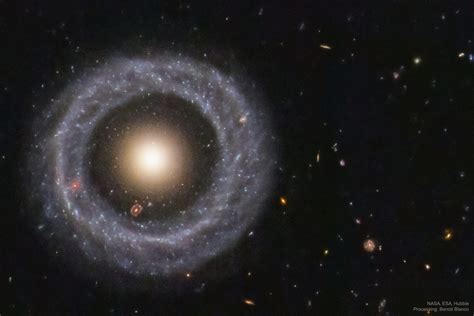Astronomers have recently discovered a colossal ring of galaxies spanning 1.3 billion light-years across, causing a stir within the cosmology community. This striking structure challenges our understanding of the cosmos and raises significant questions about the large-scale topology of the universe. The intricate arrangement of these galaxies in a ring-like formation suggests underlying cosmic phenomena previously unknown to science, compelling us to reconsider existing cosmological theories.
The discussions surrounding this discovery range from the statistical improbability of such a formation to the methodological aspects of how such structures can be detected and verified. One compelling angle comes from the exta href=”https://mphitchman.com/geometry/section8-3.html”a geometry of space methodologies that have been employed to trace these cosmic structures. Such large-scale formations are rare and offer unique insights into the distribution and behavior of matter in the universe. The methodology used to detect this ring involves sophisticated statistical analyses and algorithms, like the Convex Hull of Member Spheres (CHMS), which helped in distinguishing this remarkable structure from random background noise.
A common argument presented by skeptics is the potential randomness of the observed ring. As one commenter noted, given the immense number of galaxies in the universe, it is not entirely implausible that statistical anomalies or random noise could result in formations that appear structured from our vantage point. However, this line of reasoning has been countered effectively by rigorous statistical analyses showing a deviation from random expectations up to 5.2 sigma, a standard threshold in scientific research that indicates less than a 1 in a million chance of the structure being a random arrangement.
Further adding to the intrigue, some experts suggest that the appearance of the ring could be an observational artifact influenced by our point of view. The debate touches on concepts such as exta href=”https://en.wikipedia.org/wiki/Gravitational_lensing”a gravitational lensing and the cosmological principle, which posits that the universe is homogeneous and isotropic on large scales. This principle has been a cornerstone of cosmological models for decades, yet anomalies like the Big Ring compel scientists to rethink these assumptions in light of new evidence. The discovery of the ring, seen alongside previous findings of large-scale structures like cosmic filaments and voids, suggests that our universe may be more complex and structured than previously thought.
Adding to the complexity of the conversation are the philosophical implications of such discoveries. The sheer scale and orchestration required for a ring of galaxies to form naturally raise questions about underlying mechanisms that govern cosmic structures. As some commenters humorously speculated, it’s reminiscent of science-fiction scenarios involving highly advanced civilizations or alternate realities intersecting with our own. While such ideas are captivating, the reality is likely anchored in the yet-to-be-understood laws of physics that operate on a cosmic scale.
As our observational tools and techniques improve, we can expect to uncover more such extraordinary cosmic structures, pushing the boundaries of our understanding and fueling rich scientific discourse. Future research will delve deeper into the origins and implications of the Big Ring, integrating observational data from various angles and employing more sophisticated models to explain its existence. The discovery reaffirms the dynamic nature of cosmology, where each new finding has the potential to reshape our understanding of the universe.


Leave a Reply